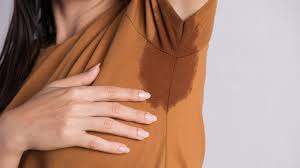
Excessive Sweating
Excessive sweating is when you sweat more than you might expect based on the surrounding temperature or your activity level or stress. Excessive sweating can disrupt daily activities and cause social anxiety or embarrassment.
Excessive sweating, or hyperhidrosis (hi-pur-hi-DROE-sis), can affect your entire body or just certain areas, particularly your palms, soles, underarms or face. The type that typically affects the hands and feet causes at least one episode a week, during waking hours.
Normal sweating helps to keep the body temperature steady in hot weather, during a high temperature (fever), or when exercising. Excessive sweating (hyperhidrosis) means that you sweat much more than normal. Even when you are not hot, anxious, or exercising, you make a lot of sweat.
Excessive sweating is classified into three types (as follows). It is important to know which type you have, as the causes and treatments are very different.
Primary (idiopathic) focal hyperhidrosis
This means that excessive sweating occurs in one or more of the following focal places: palms of the hands; soles of the feet; armpits (axillae); face/scalp.
You sweat normally on the rest of the body. It tends to be symmetrical – that is, both palms, both feet, both armpits, etc, are affected. The exact cause is not known and it is not associated with any other conditions. (The word idiopathic means of unknown cause.) It just seems that the sweat glands in these areas are overactive or more sensitive than normal. In some people, it may run in the family so there may be some genetic factor involved in causing it. It usually first develops under the age of 25, but it can develop at any age. Men and women are equally affected. It is common and affects about 3 in 100 people.
Secondary focal hyperhidrosis
This is uncommon. It means that the excessive sweating occurs in a particular focal part of the body. But, unlike primary focal hyperhidrosis, there is a known or likely cause. For example, a spinal disease or injury may cause sweating in one leg. Any focal sweating that is not symmetrical (that is, just in one hand, or one leg, etc) may suggest a secondary cause rather than primary focal hyperhidrosis which is usually symmetrical. Your doctor may suggest some tests to look for an underlying cause if one is suspected.
Treatments
Topical Antiperspirants
Topical antiperspirant sticks, creams, lotions, and solutions typically use aluminum chloride solutions. They are highly irritating with continued use, and largely ineffective for people with excessive sweating.
Anti-cholinergic drugs & tranquilizers
Medications currently used cause dry mouth, blurred vision and minimally reduce sweating.
Tap Water Iontophoresis
Various battery powered electrical devices have been used over the years which use a tap water moistened pad and electrical current held against the palms for several hours. This decreases the sweating but is very time consuming, needs to be repeated on a daily or weekly basis, and is only mildly effective for severe cases.
How is BOTOX® given?
A very small needle is used to inject small drops of Botox® into the palmar skin of the hand in approximately 30 places. The procedure takes only a few minutes in the office and requires no anesthesia. Heavy physical exercise should be avoided for several hours, but patients may engage in any normal activity. We prefer to treat one hand first and the other hand in one week.
When will BOTOX® take effect?
Your palmar sweating will decrease within 48 hours and the full effect will be seen in about 1 to 2 weeks.
How long does BOTOX® last?
Most patients will obtain 6 to 10 months of dryness after treatment with Botox®.


